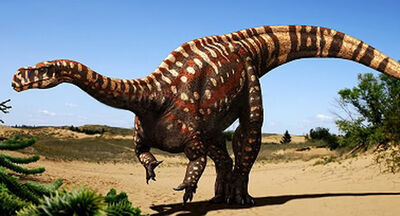
Aardonyx (Afrikaans aard, "earth" + Greek onux, "nail, claw") is a genus of prosauropod dinosaur. It is known from the type species Aardonyx celestae found from the Lower Jurassic Elliot Formation of South Africa. A. celestae was named after Celeste Yates, who prepared much of the first known fossil material of the species. It has arm features that are intermediate between prosauropods and sauropods. Massospondylus, Anchisaurus and Aardonyx were Jurassic prosauropods.
Description[]
The genus is known from disarticulated bones belonging to two immature individuals. The material consists of cranial elements, vertebrae, dorsal and cervical ribs, gastralia, chevrons, elements of the pectoral and pelvic girdles, and bones of the fore and hind limbs, manus, and pes. The presence of these bones in a single dense accumulation in a localized channel fill suggests that they came from relatively complete carcasses. Both individuals are thought to have been less than 10 years old at the time of their death because of the lack of peripheral rest lines in the cortices of sampled bones. Additional evidence for immaturity at the time of death includes calcified cartilage at the articular end of the scapula.

This is the Aardonyx partial skeleton found in 2009 in the Elliot Formation.
Aardonyx shows a transition toward the bulk-browsing form of feeding characteristic of sauropods. The jaws of Aardonyx are narrow and V-shaped with a pointed symphysis, a plesiomorphic characteristic shared with other basal sauropodomorphs. In sauropods, the jaws are broad and U-shaped to allow for a wider bite. The absence of a lateral ridge at the caudal end of the dentary is indicative of a loss of fleshy cheeks. This is seen as an adaptation for a wider gape to facilitate in bulk browsing, and is observed in nearly all sauropods. The lateral neurovascular foramina of the maxilla of Aardonyx are smaller than those of other basal sauropodomorphs, and indicate that there was a reduction in blood supply to the buccal tissues and thus a loss of fleshy cheeks. The development of lateral plates along the alveolar margins of some bones of the skull would have helped brace the lingual sides of the teeth against bucco-lingual forces during foliage stripping.
The presence of plesiomorphic V-shaped jaws along with the absence of fleshy cheeks is an unusual characteristic of Aardonyx. Previously, it was thought that broader jaws evolved prior to the reduction and loss in fleshy cheeks as an adaptation toward bulk-browsing in sauropods. The sauropod Chinshakiangosaurus possessed jaws that were U-shaped, while still retaining fleshy cheeks, the opposite of the condition seen in Aardonyx. Because Chinshakiangosaurus is a more derived sauropodomorph, this suggests that a wide, cheekless gape may have evolved twice in Sauropodomorpha: once with Aardonyx and again with sauropods more advanced than Chinshakiangosaurus.
Characteristics of the limbs of Aardonyx suggest that it was habitually bipedal. Evidence for bipedalism can be seen in the forelimbs; the structure of the radius and ulna limited the degree to which the manus could be pronated, and the length of the humerus is only 72 percent that of the femur. However, characteristics found in both the fore and hind limbs of Aardonyx show a trend toward more habitual quadrupedalism that would eventually lead to the obligatory quadrupedalism seen in sauropods.